This week, we welcome Erica Ylimäki to Sitebulb to share with us some lessons learned from doing SEO for a technology/SaaS company.
Traffic is a controversial SEO metric. It is used to measure the success of search engine optimization. However, for tech companies, and especially software as a service (SaaS) businesses, the importance and results of SEO should be measured in something other than traffic numbers.
Why? Traffic is a vanity metric.
Lily Ray has stated that SEOs should, “Optimize the forest, not the trees.” In other words, move beyond checklist optimization and focus on the end goal of conversion, not just traffic.
Let’s review how anyone doing SEO for a tech or SaaS company can find the forest and start optimizing it to create high-quality leads – and revenue.
I’ll also share the worst slip-ups I’ve made during my learning curve in doing SEO for a marketing tech SaaS company, so you won’t make the same mistakes.
Contents:
Importance of SEO for tech companies
All in-house SEOs in the tech industry feel the pain: the online space in tech is highly competitive.
If that is not bad enough, SEOs are asked to deliver results but aren’t necessarily getting the resources and budget for new projects.
According to recent research by Aira and Women in Tech SEO, 34% of in-house SEOs have reported that their budget for technical SEO has been cut. Additionally, 22% expect their budget to be cut the following year.
To top the difficulty off, organic search is undergoing serious changes in 2024 with:
AI overviews now on Google in the US
OpenAI launching its waitlist for the new AI search, SearchGPT
Instead of traditional search engines, people are using tools like ChatGPT, Gemini, Bing Chat, and Claude to research topics.
All this makes getting results in SEO even more important.
Benefits of SEO for technology companies
Here’s a reminder of just how powerful SEO can be. Effective SEO can:
Make sure people find your company
Help people choose you over competitors
Build trust and credibility
Establish a memorable brand
Be profitable in the long run
7 steps to great SEO for tech & SaaS businesses
Extensive keyword research
Check international potential
Focus on local SEO
Collect and showcase social proof
Create high-quality content
Make sure technical SEO is on point
Build a brand (=build links…)
That’s the short of it. Now to the longer, detailed explanations, including what I’ve learned since starting in SEO in 2021.
1. Take time for keyword research
Putting effort into doing keyword research properly might seem like a no-brainer, but make sure you are drilling down into all possible areas of the business.
Before logging into your favorite keyword research tool, take your notebook or laptop and talk with anyone internally who is in touch with existing or potential customers.
Internal keyword research
Research to do internally:
Ask the support team for the most asked questions they get
Go over chat conversations or support tickets
Ask the social media team what types of posts create interest in users
Ask sales and customer success which questions they get daily
Sit in on a sales meeting, and make notes on how the salesperson counters any hesitation prospects have
Ask sales what type of person is most likely to buy the product or solution
Let the CEO tell you what their vision is
Use AI and ask it questions about the business, and note down what type of responses you get and which of your competitors are presented if not you
Go over competitors’ websites
Go over your website
Aspects to focus on
When going over your notes from talking with your colleagues, focus on the following aspects:
Language and terms used by customers
Which themes come up the most?
What is missing from your website that competitors have?
What type of unique content can be added to the website to solve customers’ problems?
Now you can proceed with your typical keyword research process.
Pro tip: Once you’ve completed your initial content strategy, keep a separate list where you can add keywords to research whenever a new topic comes to mind.
I have weekly chats with our Product Manager to stay updated on updates and new features to our product. After the chat, I have plenty of new ideas, but there is rarely the time to start researching right away. Jotting them down helps me update the content plan later on.
2. Check international potential
Depending on your business, it might make sense to grow into other markets with SEO.
As translation tools have become so accessible, you can easily check whether a topic has search volumes in other languages. But be mindful that cultural and linguistic nuances may mean that basic translations don’t produce the results you’re expecting. Veruska Anconitano has written a fantastic article for Sitebulb that goes into this in detail: Multilingual SEO & Keyword Research Explained
Use AI to translate keywords into another language, and check how the SERPs look in that language, but leave the proper keyword research and localization to humans.
Pro tip: You can easily use Google Translate in Google Sheets to speed up the checking process.
Here, in column B I have the original keyword in Spanish, and in C is the translation in English to give an idea of what the keyword means.
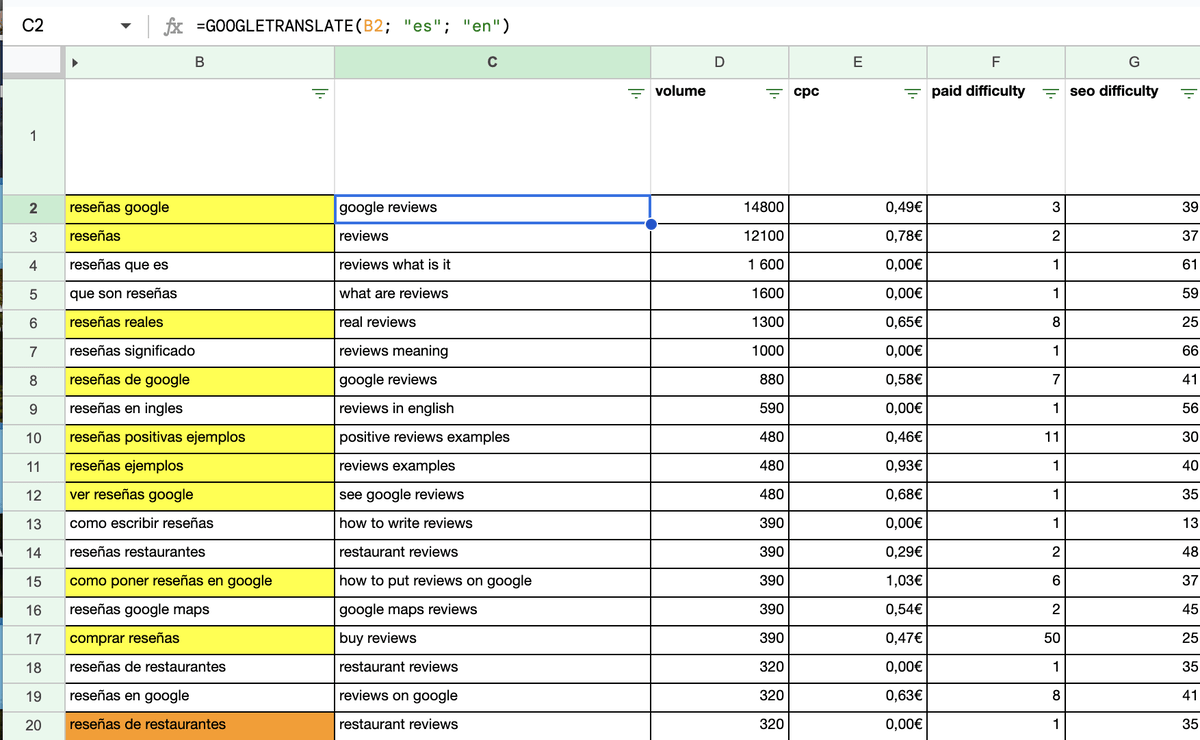
Publish auto-translated content with caution
Testing whether there is some organic traction in a language market can be done on a low budget by using AI.
However, publishing low-quality content may harm your brand’s reputation for good in that language market. Get a real human to go over the content.
My native language is Finnish and I can spot a machine-translated Finnish page a mile away. It gives off scam vibes, and I won’t give my contact information or place an order on such a site.
I’m the right person to warn everyone about this, as we opted for quantity over quality in translated content back in 2022.
It was a double-edged sword: On the one hand, it initially enabled us to grow globally and get users from each country in the world. On the other hand, fixing that mountain of bad content in four different languages is still one of our hurdles today.
3. Local SEO
If your tech company has a physical location or serves specific regions, optimize your site for local searches.
Local SEO checklist
Create and optimize a Google My Business profile: Ensure your business information is accurate and up-to-date.
Local keywords: Incorporate local keywords into your content.
Get listed on all relevant directories: Try to search for your competitors and for your services. Create a listing or a profile on all relevant directories.
Add contact information to the website: Better yet, add how to reach you with public transport, where to park a car, or a phone number to reach you.
Add videos and photos to your listing: Having visuals help people find you and know what you sell.
Connect your social media handles with your website and listings: This boosts credibility, and you might even get new followers!
This is just the tip of the iceberg, but check out Semrush’s local SEO checklist for more details.
4. Collect and showcase social proof
As there is so much competition in the tech space, people are picky with their choices.
Before booking a demo or talking with a sales rep, people considering whether or not to buy will look for:
Customer reviews
Any online forum discussions
Case studies
Videos and photos
Anything that pops up when they enter your brand into a search engine
For customer reviews in the tech space, there are Capterra, G2, and GetApp, to name just a few big brands. In addition, there are dozens of smaller independent review sites for different niches.
Make sure you know where your potential customers look you up and how your brand is scoring according to these sites.
Collect reviews
Are you collecting reviews? If not, start that right away.
Reviews are, in essence, open feedback that gives you insights into what people like, and what you should improve to make them happy.
You’ll most probably get new ideas you can use to create new features or products.
Aim for a steady flow of reviews, because according to research by Power Reviews:
97% of consumers consider review recency to be a factor in the credibility of a business
44% want to find a review that is less than a month old before buying
62% won’t buy from a brand whose reviews are more than a year old
Pro tip: Create a process where you automatically collect feedback and customer reviews at certain stages of a customer's lifetime.
Add social proof to your website
When did you last update your testimonials, case studies, or that client logo reel on your homepage?
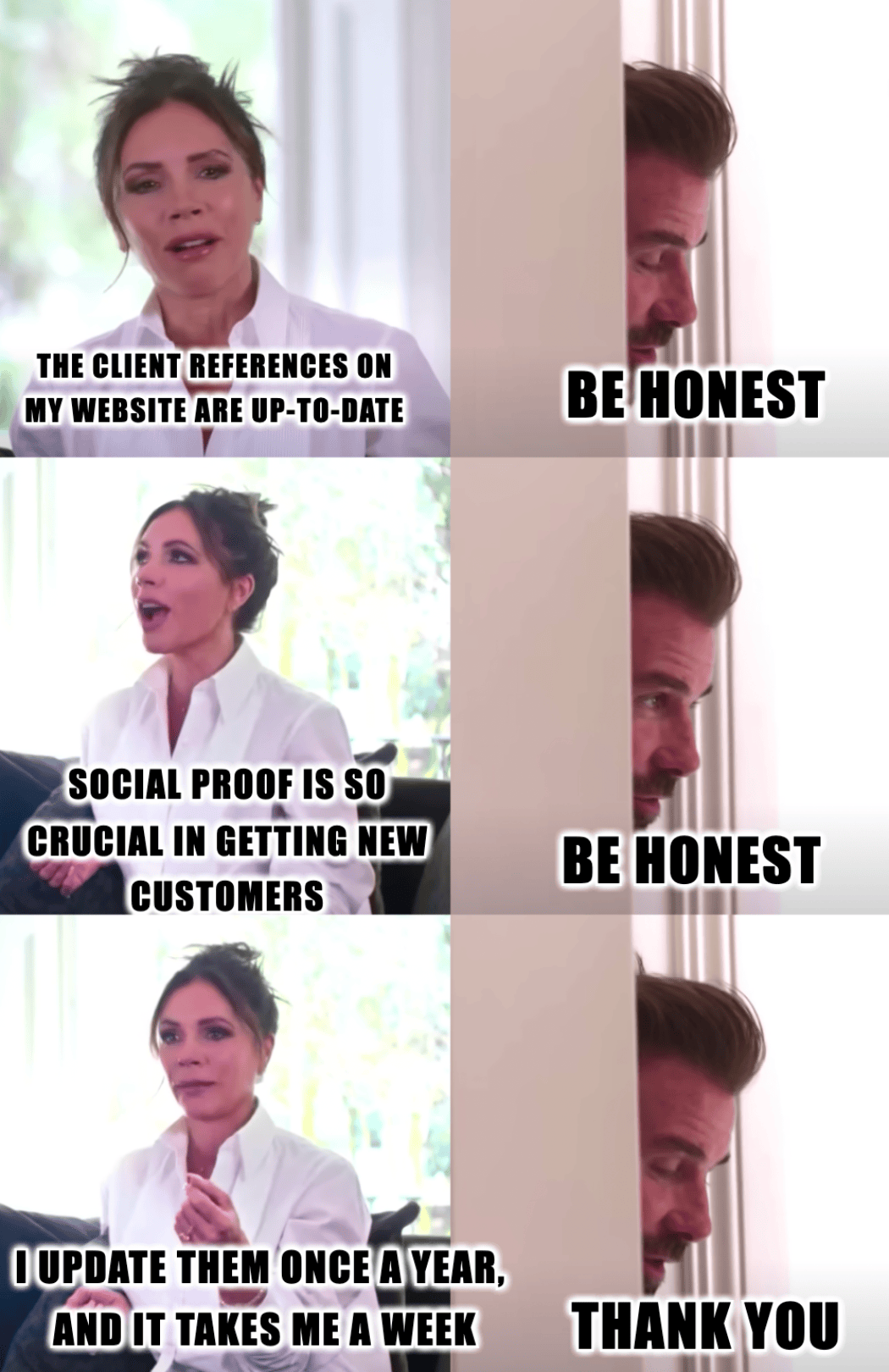
The standard way to show social proof on your website is to add the logos of your biggest and most well-known customers to your homepage.
Unfortunately, they aren’t relatable for smaller companies.
While they add credibility to your brand, they can lack relatability to the average potential customer.
Pro tip: Add all your reviews to your website to boost trust in your brand. Placing reviews from all sources on your website will keep people longer on your site because you’re spoon-feeding them the information they want to find.
Add reviews to high-purchase intent landing pages, and don’t forget to add review schema for search engines to make sure you’re beating your competitors in SERPs.
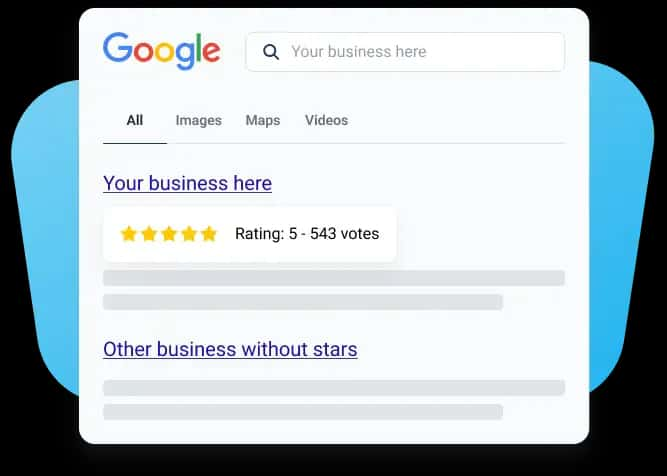
5. High-quality content creation
Create valuable, informative content that addresses the needs and questions of your target audience.
Don’t limit yourself to landing pages and blog posts.
8 content types to try in SEO for tech companies:
Case studies
How-to guides
Whitepapers
Transcribe existing webinars and podcasts
Create new webinars and podcasts
Alternative pages
Product pages
Product releases
Think about ranch-style SEO: Create content that will help the users.
Ranch-style SEO is all about creating in-depth high-quality content, but each piece of content is a standalone bite-size piece that aligns with the user’s intent and purchase journey.
So, instead of covering a topic from all angles with one huge blog post or landing page, you’d create shorter snippets of content, and internally link them together.
A real-life example by Helene Jelenc of how NOT to do ranch-style SEO was presented at the Zagreb SEO Summit. In her research on transactional pages, Helene showed that Copy.ai had lost its top two ranking for the competitive transactional keyword “ai email writer” after adding hundreds of extra words to the landing page.
The landing page with added content dropped all the way to the 17th position in the SERPs.
Helene suspected that the ranking took a hit because the content wasn’t as straight-to-the-point anymore, a quality that end users appreciate when it comes to transactional search terms.
6. Technical SEO
Make sure your website is technically optimized for search engines.
I’m not a pro at this whatsoever, but luckily there are many technical SEO experts, such as:
Sam Taylor with her technical SEO for Ecommerce
Charlie Whitworth and his advanced techniques to enhance SEO audits
The principles of technical SEO are the same for tech companies as for all other industries.
Mobile-friendliness: Your site should be fully responsive and perform well on all devices.
Site speed: Fast-loading pages are crucial for user experience and SEO rankings.
Security (HTTPS): Having a secure site is essential for building trust and is favored by search engines.
Clean URL structure: Use clear, descriptive URLs that include relevant keywords.
Pro tip: Use your website on a mobile device. Try to book a demo or buy a product. If the experience sucks, make changes to it until it doesn’t.
I’ve wasted hours trying to get our development team to perform niche technical improvements to our site, for example, when Core Web Vitals marked our INP red. Turns out, fixing it wasn’t as critical as I thought.
We operate on a headless Javascript (Next.js), so our INP score wasn’t initially up to standards according to the Core Web Vitals. However, that doesn’t mean that the user experience sucked, either.
Here’s an example of how different JavaScript frameworks pass INP in Core Web Vitals:
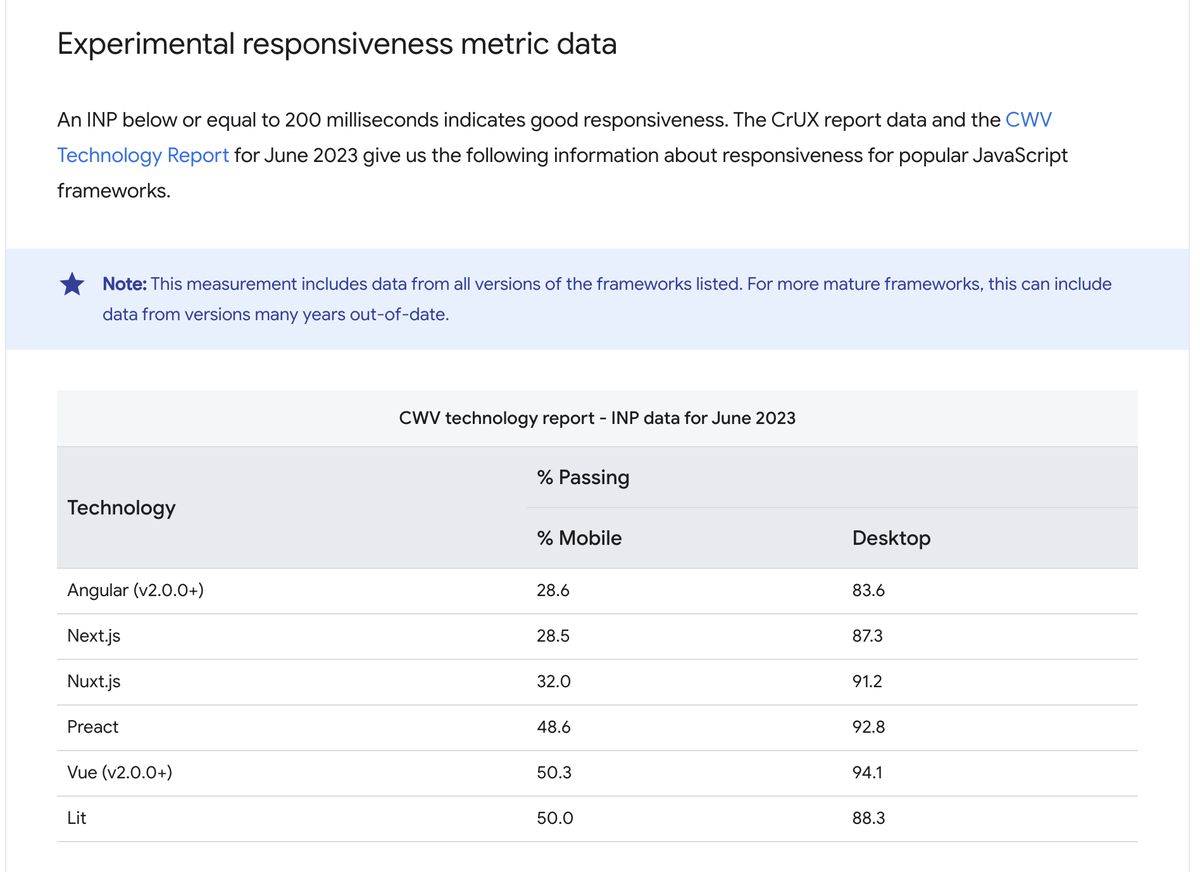
Screenshot from: https://developer.chrome.com/docs/aurora/inp-in-frameworks
This data is from 2023.
After conversations with our CTO, it was decided in 2023 that focusing only on improving our INP isn’t the key to improving rankings in our case, as our competitors on the SERPs had similar or even worse INPs.
When INP was introduced, only 28,5% of sites using Next.js had good INP in mobile. Today, 43,21% using Next.js pass in the mobile performance INP.
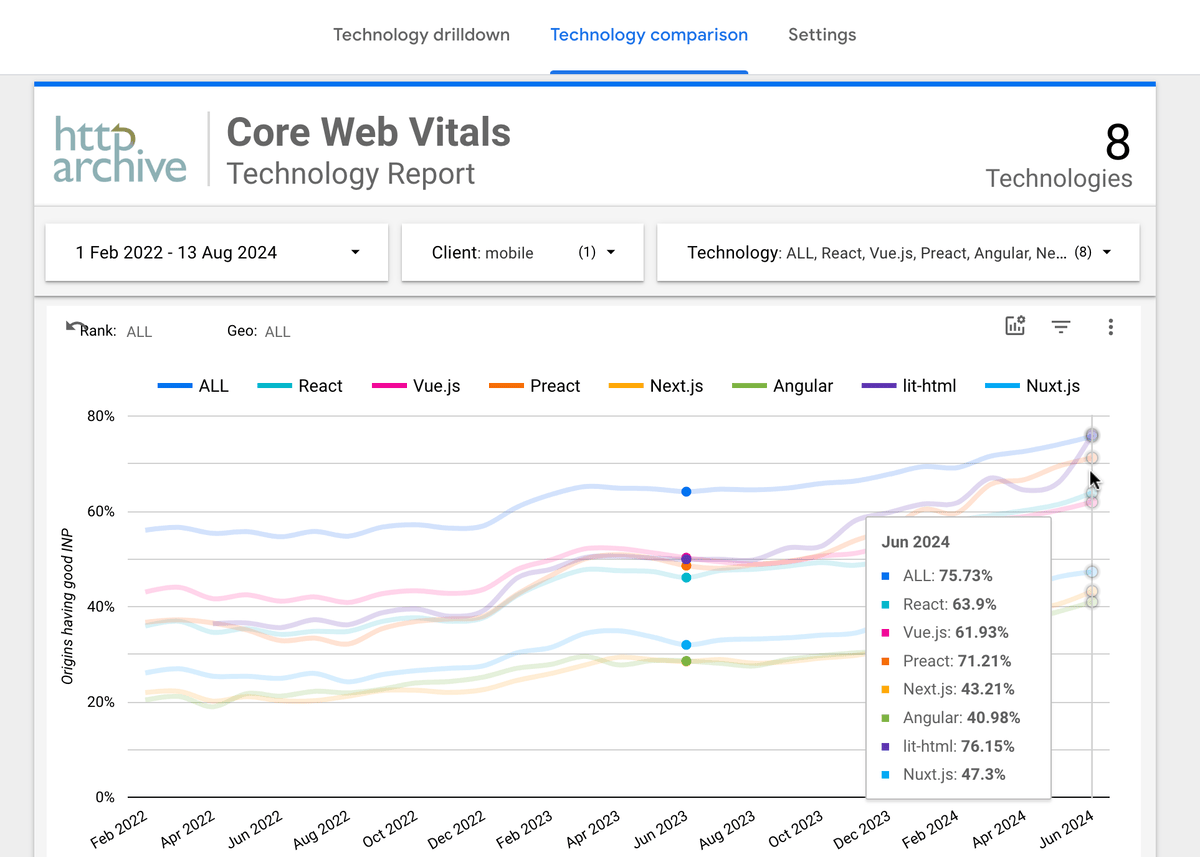
Screenshot from: Core Web Vitals Technology Report (cwvtech.report)
We’re among the sites that now pass, but it hasn’t skyrocketed our rankings. INP alone has made zero difference.
Similarly, Brian Harnish underlines in the Search Engine Journal that improving INP doesn’t guarantee SEO success.
As with all things SEO: Compare your performance on a given technical SEO metric against your major competitors. Outperforming them on the technical side might make a difference. It also might not.
Try to see things with the eyes of the intended user, not just tools and whether they are green or red.
7. Build a brand (=build links…)
Link building has a bad reputation. I get dozens of “dear sir” emails daily where people push to get me to add their link to our website.
Building valuable links is the aim of the game, and that’s about making sure you are referred to from the right places online.
Digital PR is where it’s at, and it refers to building a brand by getting mentions from reputable online publications.
This is a time-consuming strategy, but you’re playing the long game anyway.
5 strategies to build a brand with links:
Get your colleagues to attend podcasts or webinars
Build relationships with local journalists who write about your niche
Create profiles on different review sites & add your website to the description
Pitch and write high-quality guest posts for relevant sites
Participate in online forum conversations relevant to your brand
What not to do in SEO for technology brands
Don’t get discouraged!
As search is constantly evolving, you’ll need to test and adjust your strategy accordingly. And be clear about what you’re doing, why you’re doing it, and what the outcomes could be – so you can explain your approach to stakeholders.
For example, depending on your website’s history, you might face a traffic decline when you opt for creating more bottom-funnel content that converts. But what would you rather have, more quality conversions, or lots of high-bounce traffic?
Make sure you’re being clear on what you’re bringing to the table.
I learned this the hard way. Let me tell you what happened.
Traffic is down, am I getting fired?
When we changed our bulk traffic optimizing strategy to a more conversion and revenue-focused SEO strategy, our traffic declined.
Hard.
Everyone was on my back about the declining traffic numbers, even though we were getting more users and paying customers from organic traffic than ever.
It wasn’t enough to say, “But I’ve checked that the traffic is mainly down from articles that don’t bring in revenue.”
I got our Sheets expert to help me showcase tangible results so I could prove the strategy was working. Below is a screenshot showing that 60% of our traffic decline was caused by 12 URLs that brought no signups or very low-quality signups.
This helped management understand that the quality of the traffic was improving.
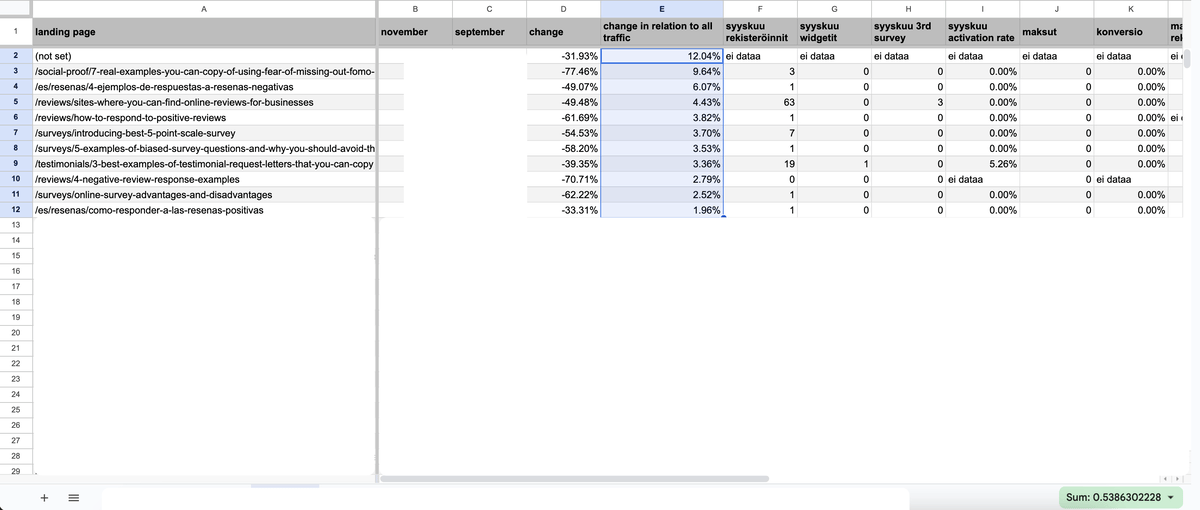
By filtering the table differently, I also showed that the activation rate from some URLs was great despite some traffic losses, as you can see in column N.

To further prove my point about creating great results with SEO, I compared two months together, where one had high traffic and the second was two months later with a declined traffic, and measured what percentage started paying for our services.
Column P shows the conversions in the month with high traffic, whereas column Q shows how the quality of the signups significantly improved even with the traffic dip.
At the end of the day, it matters how many people start paying for your services. Not how many eyeballs you get on a piece of content.
Don’t be an island
Find a community and network with like-minded people. Seriously.
I wish I had joined Women in Tech SEO and MostlyMarketing when I started doing SEO.
The people in these Slack groups have helped me advance my understanding of SEO, and most importantly, made me feel less alone in my work.
Being in touch with people who understand your daily struggles helps you stay motivated, plus you always have someone to run your ideas and issues by.
You might also like:

Sitebulb is a proud partner of Women in Tech SEO! This author is part of the WTS community. Discover all our Women in Tech SEO articles.

Self-learned SaaS SEO marketer with a background in linguistics and teaching. Enthusiastic knitter and mom of two. Interested in conversation analysis, learning new skills, and finding new ways to complete repetitive tasks.
Articles for every stage in your SEO journey. Jump on board.
Related Articles
 SEO in 2026: 17 Expert Tips & Predictions
SEO in 2026: 17 Expert Tips & Predictions
 How to Stay Relevant in a World of AI Overviews & Query-Fans
How to Stay Relevant in a World of AI Overviews & Query-Fans
 Back to Basics: 3 SEO Pillars That Will Future-Proof Your Organic Growth
Back to Basics: 3 SEO Pillars That Will Future-Proof Your Organic Growth
 Sitebulb Desktop
Sitebulb Desktop
Find, fix and communicate technical issues with easy visuals, in-depth insights, & prioritized recommendations across 300+ SEO issues.
- Ideal for SEO professionals, consultants & marketing agencies.
Try our fully featured 14 day trial. No credit card required.
Try Sitebulb for free Sitebulb Cloud
Sitebulb Cloud
Get all the capability of Sitebulb Desktop, accessible via your web browser. Crawl at scale without project, crawl credit, or machine limits.
- Perfect for collaboration, remote teams & extreme scale.
If you’re using another cloud crawler, you will definitely save money with Sitebulb.
Explore Sitebulb Cloud
 Erica Ylimäki
Erica Ylimäki


